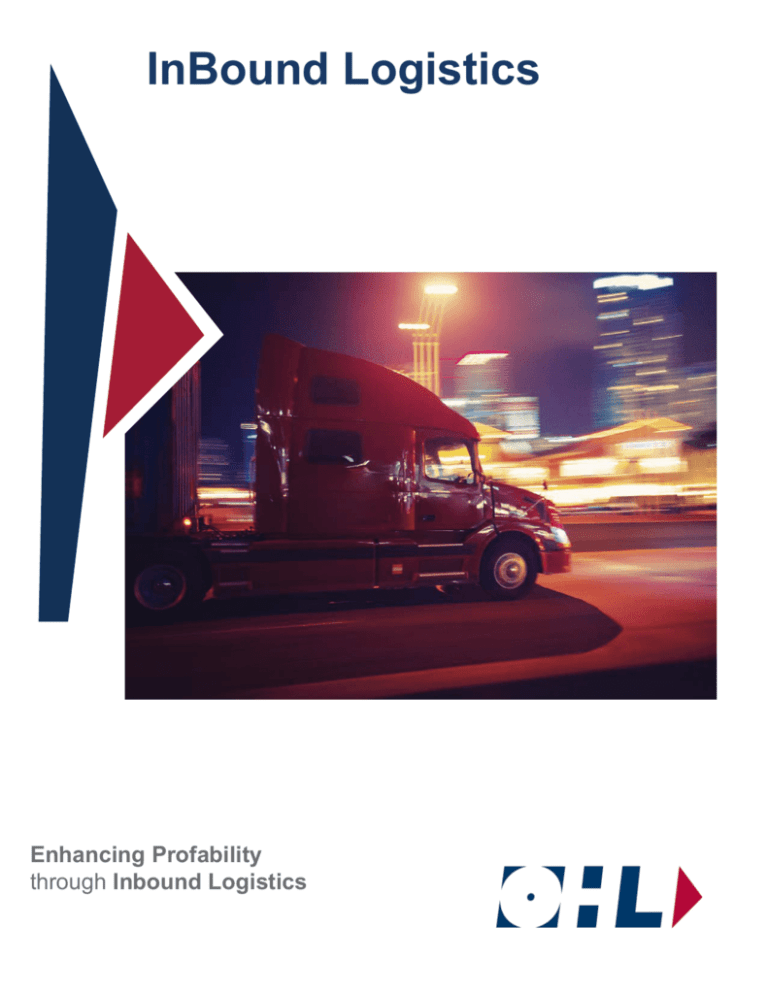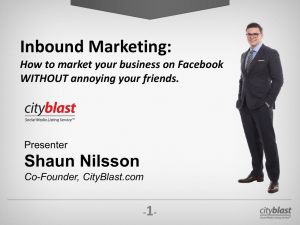Inbound Logistics multiple pages.indd
advertisement

InBound Logistics Enhancing Profability through Inbound Logistics What You Don’t Know About INBOUND LOGISTICS Could Be Costing You You probably have a good handle on your Outbound Logistics. It’s a critical link connecting you with your customers, and many companies have already found ways to drive down outbound logistics costs and become more efficient. Unfortunately, what you don’t know about managing your inbound logistics process could be costing you a lot of money. Money that could be going straight to your bottom line. OHL I Enhancing Profitability through Inbound Logistics 1 INBOUND LOGISTICS is the management of goods and materials into your manufacturing locations from your suppliers or co-packers. While inbound logistics can apply to virtually any industry, we’ll use the fictitious ABC Medical Supply Company to illustrate what can happen if you don’t have control or visibility into the flow of inbound logistics from your suppliers. ABC Medical’s Cost Delivered Pricing Manuf acturer Manages Carriers Cost of Goods Manufacturer’s Transportation C ost Savings Accrues to Manufacturer Supplier’s Cost Using Low-Cost Carrier Cost of Goods Supplier’s Transportation C ost Additional Margin ABC Medical Supply has just engineered a breakthrough diagnostic tool and has firm deadlines to deliver the product to hospitals and clinics all across the country. Typically, ABC’s procurement department chooses specialty component suppliers based primarily on getting the best material price available. It is “delivered pricing,” meaning that the cost of transportation is built into the price of the materials, and ABC’s suppliers have complete control of carrier selection and timing of the shipment. OHL I Enhancing Profitability through Inbound Logistics 2 What Issues Can This Create? UNKNOWN TRANSPORTATION COSTS For one thing, ABC’s suppliers try to protect themselves from unknown transportation costs. These transportation costs are driven by market capacity and demand, and often include a significant safety margin in their delivered pricing. These built-in costs make it difficult for ABC to understand the true cost per unit for their material purchases. To make matters worse, if ABC’s suppliers negotiate better pricing with the carrier, the supplier keeps the additional margin. So naturally, the supplier has a huge incentive to use the low-cost carrier, but they pay little attention to service or quality of carrier. OHL I Enhancing Profitability through Inbound Logistics 3 LACK OF OPTIMIZATION Another issue a company may face is the lack of optimization in their shipments. In order to manage their inventory carrying costs and get paid quickly, ABC’s suppliers move products off their docks as soon as possible. A fair-enough motivation, but based squarely on the supplier’s best interest, not necessarily the best interest of ABC Medical Supply. ►Often materials arrive by LTL carrier without any consideration of load optimization or consolidation. ►Consolidation of materials is generally ignored. More efficient modes are overlooked. ►ABC will often receive multiple LTL shipments from the same supplier each day, especially near the end of the month or quarter. ►ABC has no control over when goods are shipped, and no clear visibility into when carriers will arrive at their facilities. As a result ABC makes educated guesses for planning shipment-receiving labor each day. OHL I Enhancing Profitability through Inbound Logistics 4 Benchmarking Against Different Metrics But, ABC Medical Supply’s biggest issue may be that they don’t even realize that this “problem” exists. This can occur because key departments within a company are siloed. Procurement is charged with negotiating the best possible price of goods, but since they rarely interact with Corporate Finance, they are actually working toward different metrics than the broader end-to-end efficiency goals of the CFO. The bottom line for ABC Medical Supply: efficiency is lost; costs increase, and those firm orders to customers potentially become backlogged or, even worse, lost business. OHL I Enhancing Profitability through Inbound Logistics 5 The Growing Case for Change In today’s environment, those costs are much tougher to absorb. Allowing suppliers to choose carriers, negotiate rates, and pay the transportation charges results in your company paying for both the product and the transportation costs on your suppliers’ terms. Control is lost, and that comes with consequences. This scenario with ABC Medical Supply illustrates two painful yet common issues that typify inbound logistics today: When suppliers have the control, they’re not worried about finding ways to maximize loads and minimize transportation costs. They just want to get product out the door as quickly as possible so they can get paid as quickly as possible. Opportunities to consolidate shipments or shift from LTL to full truckload are lost, along with potential savings. Like any good business, suppliers will strive to structure a pricing agreement in their favor. Then any freight rate reduction they can negotiate after that enhances their own margins, at their clients’ expense. Suppliers don’t have skin in the game to optimize their clients’ inbound processes. Senior financial leaders often don’t have insight into how these inefficiencies are chipping away at their company’s cost management, service to customers and profitability. During periods of fast growth, many companies do not worry about the embedded costs vendors pass along to them. Growth covers up or marginalizes inefficiencies and unnecessary charges. OHL I Enhancing Profitability through Inbound Logistics 6 A Roadmap to Optimized Inbound Logistics If you don’t manage your inbound logistics today, or if you rely on your suppliers like the ABC Medical Supply does, a critical first step is to separate transportation costs and the actual cost of the goods. This additional detail may mean renegotiating the terms of sales and materials agreements with your suppliers. Or, perhaps you do manage inbound logistics today. But you lack effective processes or tools to gain control over supplier compliance and drive cost savings. By incorporating the benefit of transportation management software (TMS) technology, you can dramatically improve visibility into shipment activity, ensuring delivery of the right product to the right location at the right time and through the right mode. Today, companies have another option to help deliver an improved inbound logistics program. They can partner with a third-party logistics (3PL) provider who has the experience, proven technology and processes to help control and coordinate inbound logistics. Outsourcing inbound logistics to a 3PL doesn’t require a large capital expense for technology, plus it can be implemented with a seamless EDI integration and full back-office support. You gain expertise, objectivity, a single source of accountability and cost savings. OHL I Enhancing Profitability through Inbound Logistics 7 No matter what option you choose, A KEY PROCESS CHECKLIST for any Inbound Logistics program should include: ✓ ✓ A review of supplier business processes, terms of sale, etc. ✓ Identification and mapping of your own internal processes for ordering and managing suppliers. ✓ ✓ ✓ ✓ Monitoring supplier shipments to verify that orders are shipping on time. Ensuring advance notice of late shipments to enable the adjustment of receiving and production schedules, as well as labor, is critical. Deployment and use of TMS technology that will allow for consolidating shipments and optimizing transportation modes, where possible. Reporting on supply chain performance and unit cost metrics through monthly Key Performance Indicators. Using data analytics to gain insights for driving efficiencies and pinpointing problem areas. OHL I Enhancing Profitability through Inbound Logistics 8 The Financial Benefits of a Well-Run Inbound Logistics Program The best news is that gaining control over inbound shipments doesn’t have to come with significant capital cost, and it can provide a quick return on investment. For example, a 3PL solution offers Web-based TMS tools and cost-effective processes that deliver supplier routing compliance and drive an array of improvements that all have economic benefits. These include: 1. Evaluating LTL shipments from all suppliers and developing a strategic approach for grouping individual orders across facilities and consolidating them into a single truckload to common destinations. 2. Lowering inventory carrying costs by ensuring suppliers’ goods arrive on time at the optimal cost of arrival. 3. Sending manufacturers or suppliers advance shipping orders to help them plan staffing requirements and avoid confusion at the loading dock. 4. Working with transportation carriers to add inbound lanes that balance outbound lanes to further drive lower rates. 5. Aggregating transportation spend to reduce cost at no sacrifice of service. 6. Minimizing or eliminating shipping delays. 7. Ensuring the right carriers are involved in the client’s inbound logistics strategy. 8. Housing short-term or overflow inventory in “flex-space.” 9. Organizing a first-in-first-out ocean container, port docks-todistribution center handling process to avoid unnecessary and costly container detention fees. 10. Providing a user-friendly window to manufacturers, through webbased TMS. TMS shows the progress of inbound materials and when they’ll arrive. OHL I Enhancing Profitability through Inbound Logistics 9 Conclusion It’s difficult to fix problems when you might not even be aware you have them. With focus, you can gain the upper hand in managing inbound logistics, driving supplier routing compliance, reducing costs and improving efficiency. Furthermore, when inbound logistics processes are combined with a well-run outbound program, further cost efficiencies can be realized. An experienced 3PL service provider can help you discover and choose the best path and execute the program that will best serve and improve your inbound program. For more information on getting help managing your inbound logistics, please visit www. OHL.com and/or call (phone number). About OHL Based in Brentwood, Tenn., OHL is one of the largest 3PLs in the world, providing integrated global supply chain management solutions including transportation, warehousing, customs brokerage, freight forwarding and import and export consulting services. OHL operates more than 130 value-added distribution centers, offers comprehensive transportation management services, employs nearly 6,000 people and has offices worldwide. OHL has expertise in direct-to-consumer fulfillment, serves a wide range of business sectors from specialty retail to manufacturing and specializes in the apparel, electronics, printing, food and beverage and consumer packaged goods industries. OHL I Enhancing Profitability through Inbound Logistics 10







